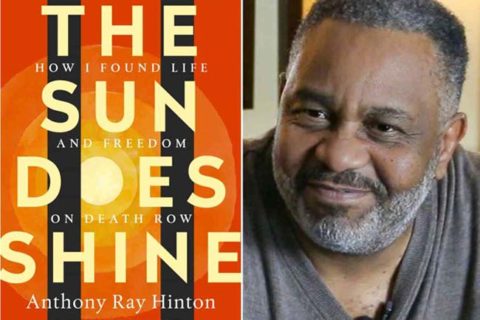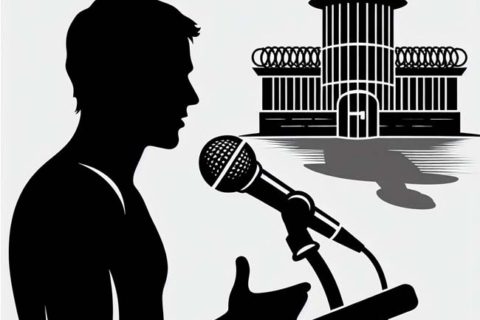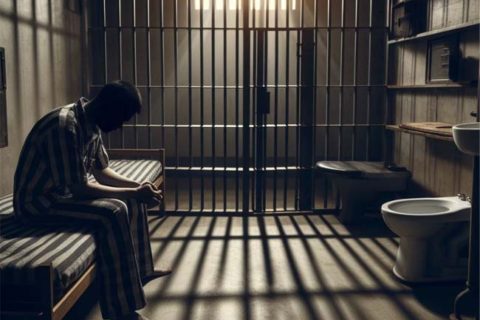If you are looking for the relationship between crime rates and concern for crime research, you are suggested to check out a journal by Yan Wnag, WEnchao Yu, Sam Liu, and Sean D. Young entitled The Relationship Between Social Media Data and Crime Rates in the United States. Below are the results of the research:
-
- State-Level Results

From the inmate above, it can be seen the positive association between crime rate index and drug-related tweets. All the tweets related to dug and crime index were highly correlated. As for a correlation coefficient, it equals to .082 at the state level. The authors plotted the relationship between drug-related tweets and crime index for every state.
-
- County-Level Results
437 county-level aggregated complete records were available for further analysis with crime rates for 2012 and 2013. In 2012 and 2013, the mean crime rate at the county level was 336.43 (SD = 184.02, range = 31–1075.2) and 341.81 (SD = 179.93, range = 53.8–995.3), respectively. The average number of drug-related tweets at the county level was 2.54 (SD = 3.33, range = −31) in 2012. The mean Gini index in 2012 was 0.44 (SD = 0.04; range = 0.33–0.60). The following table shows the correlation results between drug-related tweets, crime rates and Gini index. For 2013 data, the crime rate of the previous year was included. Keep in mind that the frequency of the drug-related tweets in 2012 was highly correlated with both the 2012 and the following year crime indexes at the county level. The population characteristics, including mea age, percentage of age 14-44 years, Caucasian, and African American was included in 2012. Basically, the correlation is highly significant with crime rate and tweets as shown on the table.
Correlation Results Between Crime Rates, Drug-related Tweets, Gini Index, Mean Age, and % of Young, White, and Black at the County Level (2012-2013)
| Variable | Crime rate (2012) | Crime rate (2013) | Tweets (drug-related) | Gini index | Age (mean) | % of young (15–44 years) | % of White | % of Black |
| N | 438 | 244 | 438 | 437 | 438 | 438 | 438 | 438 |
| M (SD) | 828.59 (1272) | 966.67 (1464) | 2.35 (3.14) | 0.44 (0.04) | 37.82 (2.83) | 0.41 (0.05) | 0.81 (0.14) | 0.13 (0.14) |
| Range | 31–10,810 | 57.3–9,502 | 1–28 | 0.33–0.6 | 28.32–49.71 | 0.25–0.66 | 0.24–0.98 | 0–0.7 |
| Crime in 2012 | 1 | 0.98** | 0.92** | 0.30** | −0.11* | 0.17** | −0.26** | 0.17** |
| Crime in 2013 | – | 1 | 0.90** | 0.32** | −0.14* | 0.19* | −0.3** | 0.23** |
| Tweets | – | – | 1 | 0.25** | −0.12* | 0.19** | −0.18** | 0.05 |
| Gini index | – | – | – | 1 | 0.01 | 0.26** | −0.39** | 0.37** |
| Age (mean) | – | – | – | – | 1 | −0.78** | 0.25** | −0.17** |
| % of young (15–44 years) | – | – | – | – | – | 1 | −0.27** | 0.2** |
| % of White | – | – | – | – | – | – | 1 | −0.91** |
| % of Black | – | – | – | – | – | – | – | 1 |
SD: standard deviation.
Correlation at county level: *p < .05; **p < .001.
In general, three negative binominal regression models were used by the authors. Not only that, two multilevel RIAS models were also used to examine the association between drug-related tweets and crime rate at the county level in 2012 and 2013, respectively. The relation between drug-related tweets and crime rate were significant in every five model for both 2012 and 2013. The model 5 achieved the best performance (smallest area under the curve [AUC]). The model adjusted for Gini index, county-level percentage of young people (15-44 years), White, and African American. In the two tables below, the multilevel models or model 4 and model 5 did better with smallest AIC. Besides, the authors also found that drug-related tweets from 2012 were associated with crime rates from 2013. Model 5, which is also known as the best fit model for predicting the 2013 crime rate at the county level, included the 2012 drug-related tweets and Gini index.
Negative Binomial Analysis for 2012 Drug-related Tweets and 2012 County-level Crime Rate
| Parameter | Estimate | SE | Pr > χ2 | AIC |
| Model 1 | 6,381.07 | |||
| Intercept | 5.74 | 0.04 | <.0001 | |
| Drug-related tweets | 0.25 | 0.01 | <.0001 | |
| Model 2 | 6,352.2 | |||
| Intercept | 3.57 | 0.39 | <.0001 | |
| Drug-related tweets | 0.23 | 0.01 | <.0001 | |
| Gini index | 4.98 | 0.88 | <.0001 | |
| Model 3 | 6,343.88 | |||
| Intercept | 2.57 | 0.47 | <.0001 | |
| Drug-related tweets | 0.66 | 0.12 | <.0001 | |
| Gini index | 7.14 | 1.07 | <.0001 | |
| Tweets × Gini index | −0.93 | 0.25 | .0003 | |
| Model 4 | 737.3 | |||
| Intercept | 4.37 | 0.34 | <.0001 | |
| Log drug-related tweets per million | 0.91 | 0.03 | <.0001 | |
| Gini index | 3.36 | 0.74 | <.0001 | |
| Model 5 | 686.5 | |||
| Intercept | 5.20 | 0.61 | <.0001 | |
| Log drug-related tweets per million | 0.92 | 0.03 | <.0001 | |
| Gini index | 1.77 | 0.77 | .025 | |
| Age (15–44 years), % | −0.97 | 0.51 | NS | |
| White % | 0.08 | 0.48 | NS | |
| Black % | 1.52 | 0.47 | .002 | |
AIC: Akaike Information Criterion (smaller value indicates better model); NS: not statistically significant in the model.
Negative Binominal Analysis for 2013 Drug-related Tweets and 2013 County-level Crime Rate
| Parameter | Estimate | SE | Pr > χ2 | AIC |
| Model 1 | 4,680.37 | |||
| Intercept | 4.89 | 0.19 | <.0001 | |
| Drug-related tweets | 0.31 | 0.05 | <.0001 | |
| Model 2 | 4,679.67 | |||
| Intercept | 2.16 | 1.67 | <.0001 | |
| Drug-related tweets | 0.29 | 0.06 | <.0001 | |
| Gini index | 6.23 | 3.82 | NS | |
| Model 3 | 3,532.97 | |||
| Intercept | 2.85 | 0.67 | <.0001 | |
| Drug-related tweets | 0.60 | 0.14 | <.0001 | |
| Gini index | 6.52 | 1.49 | <.0001 | |
| Tweets × Gini index | −0.83 | 0.28 | 0.004 | |
| Model 4 | 480.1 | |||
| Intercept | 4.25 | 0.55 | <.0001 | |
| Log drug-related tweets per million | 0.95 | 0.05 | <.0001 | |
| Gini index | 3.11 | 1.18 | 0.009 | |
| Model 5 | 447.6 | |||
| Intercept | 4.95 | 0.90 | <.0001 | |
| Log drug-related tweets per million | 0.92 | 0.04 | <.0001 | |
| Gini index | 0.62 | 1.19 | NS | |
| Age (15–44 years), % | 0.13 | 0.70 | NS | |
| White % | 0.25 | 0.68 | NS | |
| Black % | 1.81 | 0.68 | 0.018 | |
AIC: Akaike Information Criterion (smaller value indicates better model); NS: not statistically significant in the model.
The outcomes of the multilevel RIAS model resulted in a similar association between log-transformed crime rates and drug-related tweets at the county level, while the fixed affects indicated a positive association (p < .001) between the mean effect of crime rate and drug-related tweets. The fixed effects of coefficients showed a significant relation between crime and tweets when controlling for income inequality. They expected a 9.5% increase in the crime index rate per 1 million population when drug-related tweets increased by 10%. It is stated that the negative correlation between the random-effect intercept and slope was estimated to be -0.14, with a p-value of 0.01 showing that the effect of the drug-related tweets depended on the average number of crimes in the county.

A bookworm and researcher especially related to law and citizenship education. I spend time every day in front of the internet and the campus library.




